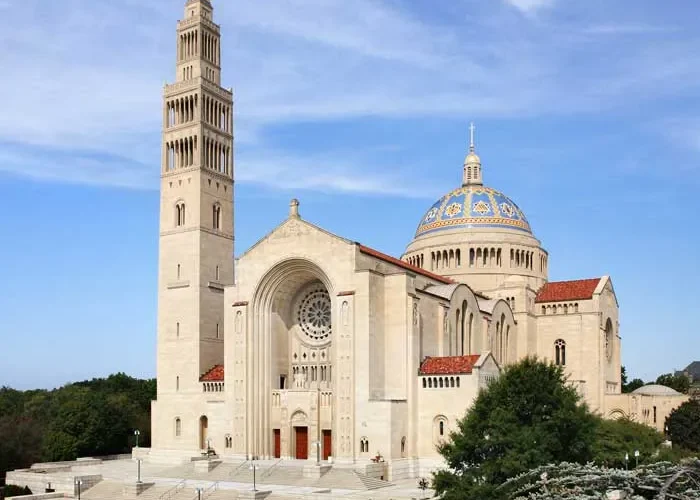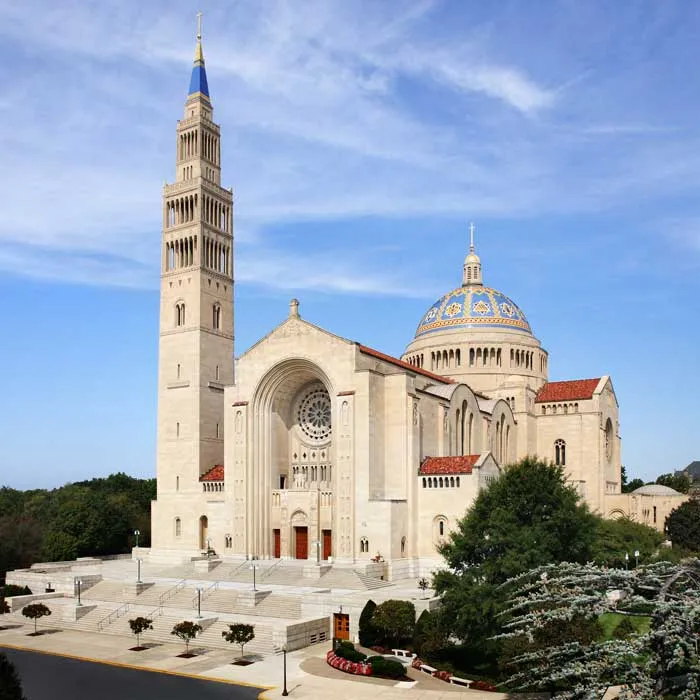
Introduction
The Basilica of the National Shrine of the Immaculate Conception Washington D.C. is a large Catholic minor basilica and national shrine located in Washington, D.C., United States, on 400 Michigan Avenue NE adjacent the Catholic University of America.
The shrine comprises the largest Catholic church building in North America, and one of the largest in the world. The basilica is also the tallest habitable building in Immaculate Conception Washington D.C. Its construction of Byzantine Revival and Romanesque Revival architecture began on September 23, 1920, with renowned contractor John McShain and was completed on December 8, 2017, with the dedication and solemn blessing of the Trinity Dome mosaic.
The Basilica is the national and patronal Catholic church of the United States, honoring the Immaculate Conception as Patroness, accorded by Pope Pius IX in 1847. Pope Pius XI donated a mosaic rendition of the image in 1923. The shrine has merited several papal visits, namely the following:
- Pope John Paul II raised the National Shrine to the status of Minor Basilica on October 12, 1990.
- Pope Benedict XVI bestowed a Golden Rose on April 16, 2008.
- Pope Francis canonized Saint Junípero Serra, O.F.M., on September 23, 2015.
The Basilica does not have its own parish community, but serves the adjacent Catholic University of America, the United States Conference of Catholic Bishops, and hosts numerous Masses for various organizations of the Church from across the United States. The basilica is not the cathedral church of the Archdiocese of Washington, as that title and honor belongs to the Cathedral of St. Matthew the Apostle.
The shrine’s rector is the Reverend Monsignor Walter R. Rossi.
The Basilica of the National Shrine of the Immaculate Conception Washington D.C. truly is the embodiment of the people who are the fabric of the Catholic faith and mosaic of our great nation.
Affectionately referred to as America’s Catholic Church, the Basilica of the National Shrine of the Immaculate Conception has been a century in the making.
Although its foundation stone was laid in 1920, this great shrine seems to have been conceived of as early as 1846, the year the Bishops of America declared the Blessed Virgin Mary the patroness of the United States under her title of the Immaculate Conception Washington D.C.. That year, the Lowell Courier Journal, a newspaper in Massachusetts, wrote of “a magnificent Catholic Church to be built at Washington, D.C. after the manner of the great cathedrals of the Old World from subscriptions of every Catholic Parish in America.”
Through the generosity of generations of American Catholics, the Basilica of the National Shrine of the Immaculate Conception stands as our nation’s preeminent Marian shrine and patronal church, rivaling the great sanctuaries of Europe and the world, not only in size and stature, but also in beauty, dignity and sanctity.
Blessing Of The Land
At 9:30 a.m. on May 16, 1920, Archbishop Giovanni Bonzano, Apostolic Delegate to the United States, celebrated Mass and blessed the site of the future National Shrine. More than 6,000 people attended the event, including 1,500 Knights of Columbus and 500 Daughters of Isabella. This significant event marked the beginning of the National Shrine’s construction process.
Patronage of the Immaculate Conception
In 1792 John Carroll, the bishop of Baltimore and the United States’s first Catholic bishop, consecrated the newly created United States under the protection of the Blessed Virgin Mary under the title of the Immaculate Conception. In 1847, the 7th Provincial Councils of Baltimore reiterated this episcopal choice to name the title Virgin Mary, conceived without sin as the principal patroness of the land. Pope Pius IX formalized the decision on February 7, 1847, and it was published on July 2, 1847.
History of Basilica of the Immaculate Conception
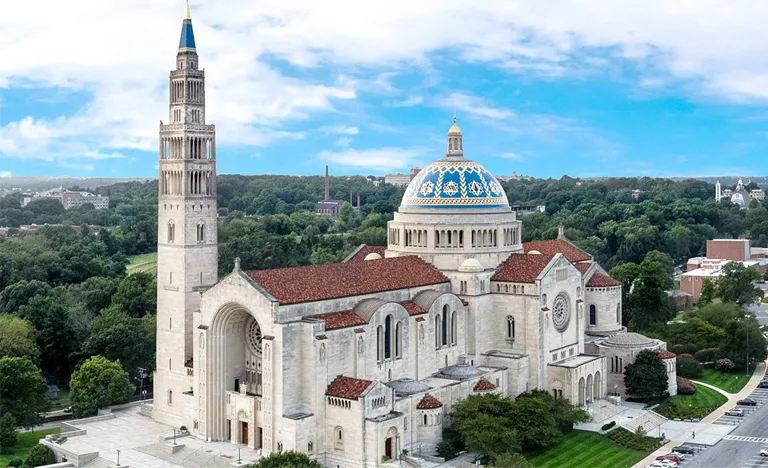
Completion (20th Century)
Bishop Thomas Joseph Shahan, the fourth rector of The Catholic University of America in Washington, proposed the construction of a national shrine to commemorate the Immaculate Conception in the country’s capital. Bishop Shahan took his appeal to Pope Pius X on August 15, 1913.
Shahan received the pope’s enthusiastic support and personal contribution of US$400 ($10,000 adjusted for inflation). Shahan returned to the United States and persuaded the board of trustees of The Catholic University of America to donate land at the southwest corner of the campus for his shrine.
In January 1914, Shahan published the first issue of Salve Regina, a newsletter meant to stir enthusiasm for his project. He wrote that the shrine would be a “monument of love and gratitude, a great hymn in stone as perfect as the art of man can make it and as holy as the intentions of its builders could wish it to be.” His newsletter was circulated to dioceses throughout the country and financial donations began to pour into Washington. In 1915, Shahan appointed Father Bernard McKenna of Philadelphia as first director of the national shrine. Shahan oversaw the construction of the shrine until his death on March 9, 1932. His are the only remains interred at the basilica/national shrine.
By 1919, Shahan and McKenna chose architectural drawings by the Boston firm of Maginnis & Walsh for construction of the national shrine. Initially, they considered a traditional Neo-Gothic architectural style, but Shahan opted instead for a Byzantine Revival-Romanesque Revival design. Cardinal James Gibbons, archbishop of Baltimore, blessed the foundation stone on September 23, 1920. More than 10,000 people attended the Mass, including ambassadors, government officials, and military officers. In 1929, the Great Depression halted the construction above the Crypt Church level. The beginning of American involvement in World War II stalled plans even further.
After the war, in 1953, American bishops under the leadership of John Noll, archbishop ad personam of Fort Wayne, and Patrick O’Boyle, archbishop of Washington, pledged to raise the funds necessary to complete the Great Upper Church of the national shrine. On November 20, 1959, thousands of Catholics gathered with the bishops for the dedication of the Great Upper Church.
Since 1968, the Papal Tiara of Pope Paul VI has been on display inside the Crypt Church.
On October 12, 1990, Pope John Paul II raised the national shrine to the status of minor basilica. The papal bull was signed and notarized by Cardinal Agostino Casaroli. It is the 36th designated basilica within the United States.
Completion (21st Century)
In August 2006, work was completed on a mosaic covering the Redemption Dome in the Great Upper Church. Following its completion in the summer of 2007, the Incarnation Dome was blessed on November 17, 2007. A small chapel on the Crypt Church level honoring Our Lady of La Vang (Vietnam) was completed in 2006.
In 2008, during his trip to the United States, Pope Benedict XVI bestowed the Golden Rose upon the Basilica of the National Shrine of the Immaculate Conception Washington D.C.
In June 2011, a new chapel dedicated to Our Lady of Lebanon was erected within the basilica, commemorating the fidelity of the Maronite Church and its faithful. A mosaic of Saint Maroun and the Crucifixion was copied from the 6th-century Rabboula Maronite manuscript, and was donated by Cardinal Donald Wuerl. The chapel was formally consecrated by Maronite Bishop Gregory J. Mansour on September 23, 2011.
On January 26, 2013, the basilica held a televised thanksgiving Mass and enshrined two first class relics of Americans Kateri Tekakwitha and Marianne Cope, who were both canonized October 20, 2012.
Pope Francis visited the shrine on September 23, 2015, and celebrated a Mass for the canonization of Junípero Serra, O.F.M., on the mall of the Catholic University of America. The altar, ambo, and chair used for this Mass match the existing marble in the basilica. After the Mass, the papal altar was placed in front of the High Altar, and is now used as the altar in the Great Upper Church.
On February 20, 2016, the Basilica was the site of the funeral Mass of US Supreme Court Justice Antonin Scalia at which his son Fr. Paul Scalia was the celebrant.
The final architectural element was completed with the installation of the 24 tons of Venetian glass in the central Trinity Dome, one of the largest mosaics of its kind in the world. On December 8, 2017, the Feast of the Immaculate Conception, the dome was dedicated and solemnly blessed by Cardinal Donald Wuerl.
Architecture
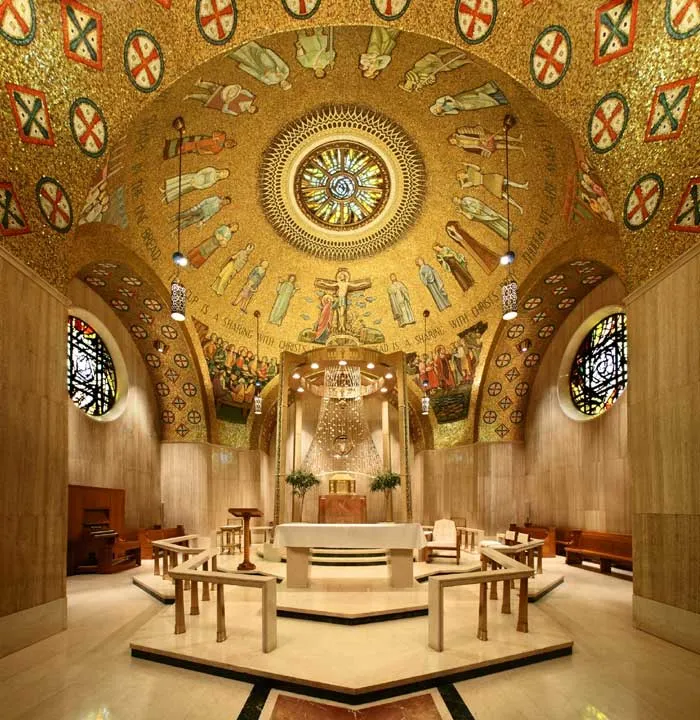
Architectural styles: Romanesque Revival architecture, Byzantine Revival architecture
Capacity : 10,000 (6,000 in the Great Upper Church; 4,000 in the Crypt Church)
The basilica houses 81 Marian chapels (including the Our Mother of Africa Chapel), as well as other sacred images, flanking the sides of the Great Upper Church and the Crypt Church. They were designed to reflect the origins of Catholic Americans and the religious orders whose generosity erected them.
Its Greek-styled interior is crowned with numerous domes decorated in mosaics, similar to the Basilica of St. Mark in Venice, Italy, but much larger. The mosaics feature American renditions of traditional Catholic images. Artist Jan Henryk De Rosen, who presided over the shrine’s iconography committee was also responsible for much of its decor, including composing the large mosaic over the northern apse.
The exterior of the basilica is 460 ft (140 m) long, 240 ft (73 m) wide, and 237 ft (72 m) tall to the top of the cross on the dome. The exterior area of the basilica is 10,234 square metres (110,160 sq ft). The diameter of the main dome (the Trinity Dome) of the basilica is only 7 feet (2 m) smaller than that of the dome of the United States Capitol. The interior area of the basilica is 7,097 square metres (76,390 sq ft) for the Great Upper Church, and 12,069 square metres (129,910 sq ft) for the Lower Level and Crypt Church, for a grand total of 19,166 square metres (206,300 sq ft).
The shrine was built in the style of medieval churches, relying on masonry walls and columns in place of structural steel and reinforced concrete. It was designed to hold 10,000 worshipers and includes modern amenities such as a basement cafeteria, hidden public address speakers to carry speech at the altar to the rear of the building, air conditioning and the largest radiant heating slab in the world (in 1959).
There are arches outlined with iridescent Pewabic Pottery tile, large ceramic medallions set in the ceiling, and fourteen Stations of the Cross in the Crypt Church.
Our Lady of America, The Immaculate Virgin
Our Lady of America, The Immaculate Virgin, Patroness of America – West Wing of the Mother of Mercy Chapel
Our Lady of America must be understood to mean Our Lady, The Immaculate Virgin, Patroness of America.
We closely collaborate with the Our Lady. Patroness of America Center in Rome City, IN, which is the Church recognized pilgrimage site for devotion to Our Lady, the Immaculate Virgin, Patroness of America (Our Lady of America).
The story of Our Lady of America truly began on May 10, 1846, when one Archbishop and 22 U.S. Bishops met in Baltimore, Maryland, (the first Catholic diocese in the United States) for the 6th Provincial Council of Baltimore. On that date they petitioned Rome, Italy to have the Blessed Virgin, under the title of the Immaculate Conception, become Patroness of the United States (only 28 states at that time). In 1847 that petition was granted by Pope Pius IX, and Mary – under the title of her Immaculate Conception – became Patroness of the United States.
It was not until eight years later, on December 8, 1854, that Pope Pius IX would define the dogma of the Immaculate Conception in his Apostolic Constitution, Ineffabilis Deus. Less than four years later, on the Feast of the Annunciation, March 25, 1858, Our Lady would confirm that dogma by identifying herself to Bernadette Soubirous in Lourdes, France, as “I am the Immaculate Conception”.
When the Blessed Virgin Mary appeared in Mexico she revealed her title as “The Perfect Virgin, Holy Mary of Guadalupe.” When Bishop Zumarraga first saw her miraculous image on St. Juan Diego’s cloak he said, “It is the Immaculate One!” Similarly, the Blessed Virgin Mary appeared in the United States and revealed her title as “Our Lady of America, The Immaculate Virgin”, another representation of the Immaculate Conception, the Patroness of the United States.
She appeared to a young nun in the United States in several apparitions during the latter half of the 20th century. The nun’s name was Sister Mary Ephrem, later Mildred Neuzil, her birth name. She was born in Brooklyn, New York, on August 2, 1916.
At the age of 14, Mildred entered the active religious congregation of the Sisters of the Precious Blood, a Papal Community, in Dayton Ohio. In the fall of 1956, Sister Mary Ephrem was sent to Kneipp Springs Sanitarium, near Rome City, Indiana.
After 1979, she became a contemplative of the Indwelling Trinity in Fostoria, Ohio, an order that never became officially recognized by the Catholic Church.
In 1938, Sister Mary Ephrem began to have mystical experiences. The principal apparitions of Our Lady of America to her took place in the chapel of the Precious Blood Sisters Convent in Kneipp Springs Sanitarium. Our Lady of America revealed her title, her image and her messages to Sister that continued until her death in her convent on January 10, 2000 at the age of 83.
This consecration was renewed by the U.S. bishops on Nov. 11, 2006 in Baltimore, Maryland. Days later, the processional statue of Our Lady of America was first publicly displayed at the USCCB conference in Baltimore, Maryland. On November 15, 2006, Raymond Leo Cardinal Burke (then Archbishop) blessed the statue. This same statue is now on public display in the West Wing of the Mother of Mercy Chapel, in Rome City, Indiana.
Devotion to Our Lady of America grew forth from alleged apparitions to Sr. Mary Ephrem, CPPS (Sister of the Precious Blood) starting when she was assigned to work at the Kneipp Springs Sanitarium (Hospital) in Rome City, Indiana in 1956. The diary of Sr. Mary Ephrem as printed in 1960 by her spiritual director, Archbishop Paul F. Leibold (Archdiocese of Cincinnati) contains a series of prayerful and graced inspirations that have emerged to be the devotion to Our Lady of America, the Immaculate Virgin, Patroness of America.
Sister Mildred Mary Ephrem Neuzil
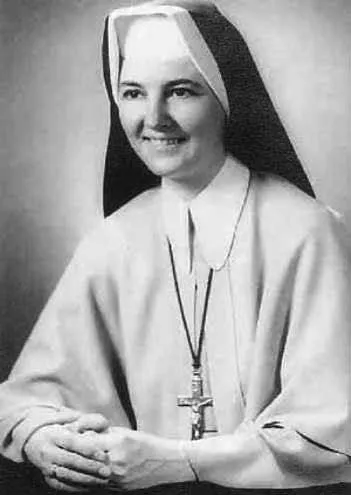
On September 26, 1956, Our Lady appeared to Sister and called her children in America to dedicate their lives to her purity. She said: My child, I entrust you with this message that you must make known to my children in America. I wish it to be the country dedicated to my purity. The wonders I will work will be the wonders of the soul. They must have faith and believe firmly in my love for them.
I desire that they be the children of my Pure Heart. I desire, through my children in America, to further the cause of faith and purity among peoples and nations. Let them come with confidence and simplicity, and I, their Mother, will teach them to become pure like to my Heart that their own hearts may be more pleasing to the Heart of my Son.
Sister Mildred said that Our Lady called herself “Our Lady of America” in response to the love and desire that reached out for this special title in the hearts of her children in America. This title is a sign of Our Lady’s pleasure in the devotion of her children of America towards her, and her visit was a response to the longing, conscious or unconscious, in the hearts of her children in America.
She entrusted Sister, as she said, with “this message that you must make known to my children in America.” to “further the cause of faith and purity among people and nations, especially through its youth.”
She revealed that the youth of America are challenged to be the leaders of this movement of renewal on the face of the earth and that they must be prepared for it by instilling in them the knowledge and study of the Divine Indwelling so that the Divine Presence becomes an intimate and necessary part of their life and daily living. Those who are willing wholeheartedly to follow her in her great battle against evil will bear the special title of “Torchbearers of the Queen,” bearing the torch of Divine Love that will conquer hate.
The Practice of the Devotion
The elements of the devotion to Our Lady of America are the image, the statue, the medal, the Divine Indwelling; the prayers and honoring St. Joseph. We practice the devotion by displaying, honoring and venerating the image or statue; wearing the medal with great devotion; practicing the Divine Indwelling; praying the prayers and the Rosary, especially as a family and by honoring St. Joseph, especially on First Wednesdays. If we practice the devotion to Our Lady of America, she promises us peace and her protection.
Canonical Approval
Sister Mildred’s spiritual director was Bishop Paul F. Leibold. He later became the Archbishop of Cincinnati, Ohio. As Our Lady requested, Bishop Leibold had a medal struck of the image and, on January 25, 1963, he approved and gave his Imprimatur to the revelations from the Blessed Virgin Mary under her title of “Our Lady of America, The Immaculate Virgin.” It is the only approved devotion in the United States based upon an apparition that occurred here.
Archbishop Raymond L. Burke, a world renowned canon lawyer, stated that the devotion to Our Lady of America was canonically approved. In a letter dated May 31, 2007, he reviewed the prior history and then state of the devotion, as well as the earlier actions of Archbishop Leibold approving the devotion.
Archbishop Burke wrote, “What can be concluded canonically is that the devotion was both approved by Archbishop Leibold and, what is more, was actively promoted by him. In addition, over the years, other Bishops have approved the devotion and have participated in public devotion to the Mother of God, under the title of Our Lady of America.”
Our Lady of America Promise
- Our Lady promised that greater miracles than those granted at Lourdes and Fatima would be granted here in America if we would do as she desires.
- The Blessed Virgin Mary has promised that her statue as Our Lady of America, once placed in the National Shrine of the Immaculate Conception, would be a safeguard for our country.
- Our Lady promised that a picture or statue honored in all homes would be a safeguard for the family.
- She also promised that the medal would be a safeguard against evil for those who wear it with great faith and devotion.
Honoring the Immaculate Conception of Mary
The Immaculate Conception Mosaic at the Basilica is a gift of the Vatican Mosaic Studio and contains 250,000 pieces of natural stone in 35,000 different hues, sanded smooth to resemble a painting. Taking more than five years to create, it is based on a famous oil painting by the Spanish artist Bartolomé Esteban Murillo, La Purísima Bionda.
Immaculate Conception of Mary (Our Lady of Conception Mary)
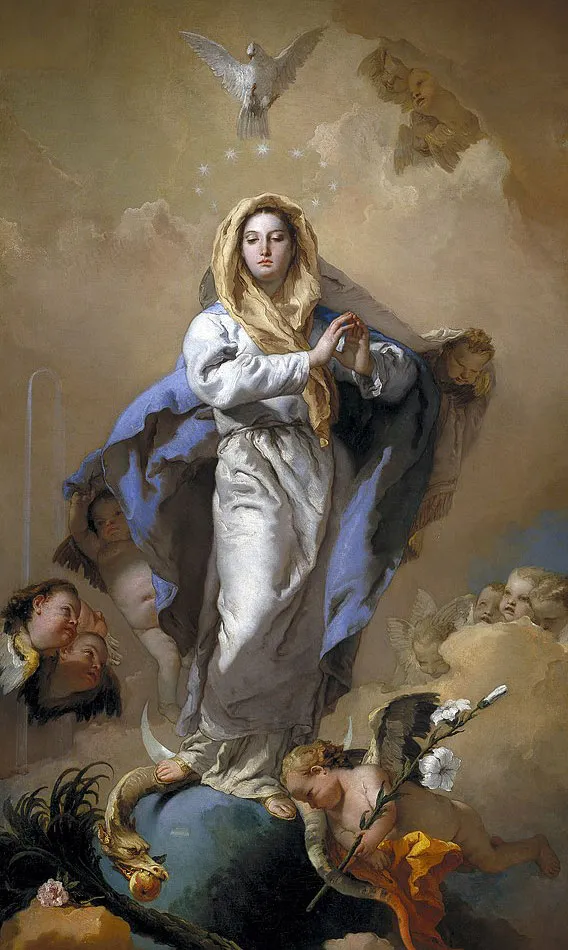
The Immaculate Conception is the belief that the Virgin Mary was free of original sin from the moment of her conception. First debated by medieval theologians, it proved so controversial that it did not become part of official Catholic teaching until 1854, when Pius IX gave it the status of dogma in the papal bull Ineffabilis Deus.
The Immaculate Conception became a popular subject in literature, but its abstract nature meant it was late in appearing as a subject in works of art. The iconography of the Virgin of the Immaculate Conception shows Mary standing, with arms outstretched or hands clasped in prayer. The feast day of the Immaculate Conception is December 8.
Protestants rejected the doctrine of the Immaculate Conception as un-scriptural, though some Anglicans accept it as a pious devotion. Opinions on the Immaculate Conception in Oriental Orthodoxy are divided: Shenouda III, Pope of the Coptic Orthodox Church, opposed the teaching; the Eritrean and Ethiopian Orthodox Tewahedo accept it. It is not accepted by Eastern Orthodoxy due to differences in the understanding of original sin, although they do affirm Mary’s purity and preservation from sin. Patriarch Anthimus VII of Constantinople characterized the dogma of the Immaculate Conception as a “Roman novelty”.
Feast Day – 8th December
December 8th, the Solemnity of the Immaculate Conception is the patronal feast day of the Basilica of the National Shrine of the Immaculate Conception, and of our nation. This Holy Day celebrates the belief that Mary was conceived in her mother’s womb without original sin.
The Feast of the Immaculate Conception dates to as early as the eighth century. It became more widely celebrated during the 18th century, with its observance in the United States predating the Declaration of Independence. Mary, under her title the Immaculate Conception, was commended to the patronage of the United States in 1846, and in 1885, the day became a national Holy Day.
At the Basilica of the National Shrine of the Immaculate Conception, the Solemnity of the Immaculate Conception is a particularly significant day. As the nation’s preeminent Marian Shrine dedicated to the Patroness of the United States, on this day we turn to prayer in a special way for the needs of our nation and its faithful.
The feast day of the Immaculate Conception is December 8th. The Roman Missal and the Roman Rite Liturgy of the Hours include references to Mary’s immaculate conception in the feast of the Immaculate Conception. Its celebration seems to have begun in the Eastern church in the 7th century and may have spread to Ireland by the 8th, although the earliest well-attested record in the Western church is from England early in the 11th. It was suppressed there after the Norman Conquest (1066), and the first thorough exposition of the doctrine was a response to this suppression.
It continued to spread through the 15th century despite accusations of heresy from the Thomists and strong objections from several prominent theologians. Beginning around 1140 Bernard of Clairvaux, a Cistercian monk, wrote to Lyons Cathedral to express his surprise and dissatisfaction that it had recently begun to be observed there, but in 1477 Pope Sixtus IV, a Franciscan Scotist and devoted Immaculist, placed it on the Roman calendar (i.e., list of church festivals and observances) via the bull Cum praexcelsa.
Thereafter in 1481 and 1483, in response to the polemic writings of the prominent Thomist, Vincenzo Bandello, Pope Sixtus IV published two more bulls which forbade anybody to preach or teach against the Immaculate Conception, or for either side to accuse the other of heresy, on pains of excommunication. Pope Pius V kept the feast on the tridentine calendar but suppressed the word “immaculate”. Gregory XV in 1622 prohibited any public or private assertion that Mary was conceived in sin.
Urban VIII in 1624 allowed the Franciscans to establish a military order dedicated to the Virgin of the Immaculate Conception. Following the promulgation of Ineffabilis Deus the typically Franciscan phrase “immaculate conception” reasserted itself in the title and euchology (prayer formulae) of the feast. Pius IX solemnly promulgated a mass formulary drawn chiefly from one composed 400 years by a papal chamberlain at the behest of Sixtus IV, beginning “O God who by the Immaculate Conception of the Virgin…”.
By pontifical decree a number of countries are considered to be under the patronage of the Immaculate Conception. These include Argentina, Brazil, Korea, Nicaragua, Paraguay, the Philippines, Spain (including the old kingdoms and the present state), the United States and Uruguay. By royal decree under the House of Bragança, she is the principal Patroness of Portugal.
Mass Time
Weekdays
Sundays
Church Visiting Time
Contact Info
400 Michigan Ave NE,
Washington, DC 20017, United States
Phone No.
Tel : +1 202-526-8300
Accommodations
How to reach the Basilica
Reagan Washington Airport (DCA) is the nearby airport to the Basilica.
Metro Train : Take Metrorail Red Line to Brookland/CUA. Take the escalator on the west side – then walk up – hill to be library, walk around the library on the south-side and you will see the basilica. The walk is approximately 3 blocks.
Bus : If you want to come by Metro Bus from downtown, take the 80 bus (which runs from the Kennedy Center through the downtown area); there is a bus stop across from the Basilica.

